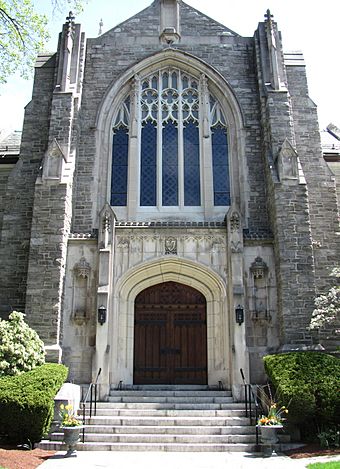Second Church in Newton facts for kids
Quick facts for kids |
|
|
Second Church of Newton
|
|

Second Church in Newton
|
|
| Location | 60 Highland Street, West Newton, Massachusetts |
|---|---|
| Built | 1916 |
| NRHP reference No. | 90000049 |
| Added to NRHP | March 16, 1990 |
The Second Church in Newton is a historic church building located at 60 Highland Street in West Newton, Massachusetts, a part of Newton, Massachusetts. It belongs to the United Church of Christ and has roots in the Congregational church. This beautiful church building, designed by architects Allen & Collens, was finished in 1916. Because of its importance, it was added to the National Register of Historic Places in 1990.
Contents
About the Church Building
The building you see today is actually the third home for this church community.
Early History of the Congregation
The church group, known as the West Parish of Newton, officially started in 1778. It was the second church parish in Newton at that time. As more people joined, they built a meeting house on Washington Street in 1848. The first church building was then used as the town hall. By the early 1900s, the church needed a bigger space because the community had grown so much.
Designing a New Home
Plans for a new church building began in 1908. The land was bought in 1913, and the first stone was laid in 1914. This was a special year because it marked 150 years since the church community began. The famous architects Allen & Collens designed the building. They were known for their Gothic Revival style, which looks like old European cathedrals. Charles Collens was the main designer for this project.
Location and Outside Look
The Second Church in Newton is on Highland Street. It's located on a small hill, which means its tall spire can be seen from far away, even from the Massachusetts Turnpike. The church building is a great example of Gothic Revival style, built with stone.
The Parish House, which is connected to the church, was started in 1915 and finished in 1938. It has stucco walls and features of the Tudor Revival style. Both parts of the building are still very much like they were when they were built.
The front of the church, facing Highland Street, has a main entrance under a curved arch. Above the entrance is a large stained-glass window. The sides of the church also have tall, pointed-arch windows.
The Tall Spire
A very noticeable part of the church is its spire, which reaches 196 feet high! It has decorative stone carvings at the top. On top of the spire are two figures: a young man looking east towards the sunrise and an old man looking west towards the sunset. This spire is a well-known landmark in West Newton.
The bell inside the tower is very old. It was brought from the church's previous building and still works today. It was made in 1848.
Unique Details
You can see interesting stone carvings called gargoyles on either side of the front entrance. To the north of the main church building is the Parish House. This part has a Tudor style with leaded windows and was added in 1938.
Inside the Church
The inside of the church, called the sanctuary, was inspired by Gothic churches from Europe built between the 12th and 16th centuries. The ceiling looks like an upside-down boat. This design reminds people of Noah's Ark and the safety it provided.
Beautiful Stained Glass Windows
The church has many beautiful stained-glass windows. Some are original, and others were added later, between World War I and the 1960s, given by church members. The oldest windows have glass from Europe and were designed by Henry Wynd Young and Charles Jay Connick.
Two windows in the Fuller Chapel were designed by Henry Wynd Young, who was a very talented artist. The windows at the back of the main church area were designed by Charles Jay Connick, a famous artist from Newtonville. These windows have special crosses at the top of each panel. Later, three more windows were added, designed by Connick Associates, with themes of world peace, caring for others, and prayer. Another window, with deep blue colors, shows the important role of healthcare workers.
Amazing Wood Carvings
The church also has detailed wood carvings made from red oak. These carvings are found at the altar, where the choir sits, and at the pulpit and lectern (where sermons are given). These carvings were created by Johannes Kirchmayer. They include natural elements like branches, birds, and small animals, showing the style of the Arts and Crafts movement.
Images for kids
See also




